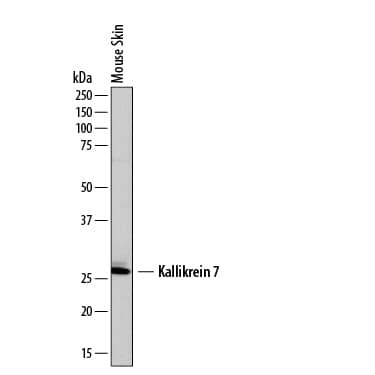Mouse/Rat Kallikrein 7 Antibody
R&D Systems, part of Bio-Techne | Catalog # AF7688

Key Product Details
Species Reactivity
Applications
Label
Antibody Source
Product Specifications
Immunogen
Gln22-Arg249 (predicted)
Accession # Q91VE3
Specificity
Clonality
Host
Isotype
Scientific Data Images for Mouse/Rat Kallikrein 7 Antibody
Detection of Mouse Kallikrein 7 by Western Blot.
Western blot shows lysates of mouse skin tissue. PVDF membrane was probed with 2 µg/mL of Sheep Anti-Mouse Kallikrein 7 Antigen Affinity-purified Polyclonal Antibody (Catalog # AF7688) followed by HRP-conjugated Anti-Sheep IgG Secondary Antibody (Catalog # HAF016). A specific band was detected for Kallikrein 7 at approximately 27 kDa (as indicated). This experiment was conducted under reducing conditions and using Immunoblot Buffer Group 1.Detection of Rat Kallikrein 7 by Western Blot.
Western blot shows lysates of rat skin tissue. PVDF membrane was probed with 1 µg/mL of Sheep Anti-Mouse Kallikrein 7 Antigen Affinity-purified Polyclonal Antibody (Catalog # AF7688) followed by HRP-conjugated Anti-Sheep IgG Secondary Antibody (Catalog # HAF016). A specific band was detected for Kallikrein 7 at approximately 27 kDa (as indicated). This experiment was conducted under reducing conditions and using Immunoblot Buffer Group 1.Kallikrein 7 in Mouse Skin.
Kallikrein 7 was detected in perfusion fixed frozen sections of mouse skin using Sheep Anti-Mouse Kallikrein 7 Antigen Affinity-purified Polyclonal Antibody (Catalog # AF7688) at 5 µg/mL overnight at 4 °C. Tissue was stained using the NorthernLights™ 557-conjugated Anti-Sheep IgG Secondary Antibody (red; Catalog # NL010) and counterstained with DAPI (blue). Specific staining was localized to keratinocytes. View our protocol for Fluorescent IHC Staining of Frozen Tissue Sections.Applications for Mouse/Rat Kallikrein 7 Antibody
Immunohistochemistry
Sample: Perfusion fixed frozen sections of mouse skin
Western Blot
Sample: Mouse skin tissue and rat skin tissue
Reviewed Applications
Read 1 review rated 3 using AF7688 in the following applications:
Formulation, Preparation, and Storage
Purification
Reconstitution
Formulation
Shipping
Stability & Storage
- 12 months from date of receipt, -20 to -70 °C as supplied.
- 1 month, 2 to 8 °C under sterile conditions after reconstitution.
- 6 months, -20 to -70 °C under sterile conditions after reconstitution.
Background: Kallikrein 7
KLK7 (Kallikrein 7; also Serine protease 6, Thymopsin and Stratum corneum chymotryptic enzyme/SCCE) is a 27 kDa (predicted), secreted glycoprotein member of the kallikrein subfamily, peptidase S1 family of enzymes. It is an IL-4 and IL-13-inducible chymotrypsin-like serine protease that has restricted expression, being associated with stratum spinosum and granulosum keratinocytes, distal and proximal convoluted tubule epithelium, limited pancreatic acinar cells. In contrast, KLK7 is widely expressed by a variety of carcinoma cell types. KLK7 preferentially cleaves peptide bonds that contain an aromatic (Tyr or Phe) residue in the P1 (or postcleavage C-terminal amino acid) position. Molecules known to serve as substrates for KLK7 include chemerin, fibronectin, E-cadherin, LL37, procaspase-14, MMP-9 and desmoglein. The nature of the KLK7 substrates indicates that it plays a key role in intercellular adhesion dissolution with subsequent cell migration. Mouse KLK7 is synthesized as a 249 amino acid (aa) precursor. It contains a 21 aa signal sequence, a four aa prosegment, and a 224 aa mature region (aa 26-249). The mature molecule contains one large protease domain (aa 26-246) and a variable, three aa C-terminus that possesses either a VSW or ASR motif. Over aa 22-249, mouse KLK7 shares 75% and 85% aa sequence identity with human and hamster KLK7, respectively.
Alternate Names
Gene Symbol
UniProt
Additional Kallikrein 7 Products
Product Documents for Mouse/Rat Kallikrein 7 Antibody
Product Specific Notices for Mouse/Rat Kallikrein 7 Antibody
For research use only


